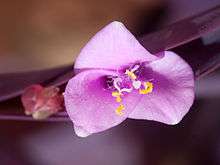Commelinales
Commelinales is the botanical name of an order of flowering plants. It comprises five families: Commelinaceae, Haemodoraceae, Hanguanaceae, Philydraceae, and Pontederiaceae. All the families combined contain over 885 species in about 70 genera; the majority of species are in the Commelinaceae. Plants in the order share a number of synapomorphies that tie them together, such as a lack of mycorrhizal associations and tapetal raphides. Estimates differ as to when the Comminales evolved, but most suggest an origin and diversification sometime during the mid- to late Cretaceous. Depending on the methods used, studies suggest a range of origin between 123 and 73 million years, with diversification occurring within the group 110 to 66 million years ago. The order's closest relatives are in the Zingiberales, which includes ginger, bananas, cardamom, and others.[2]
| Commelinales | |
|---|---|
 | |
| Tradescantia pallida | |
| Scientific classification | |
| Kingdom: | Plantae |
| Clade: | Tracheophytes |
| Clade: | Angiosperms |
| Clade: | Monocots |
| Clade: | Commelinids |
| Order: | Commelinales Mirb. ex Bercht. & J.Presl[1] |
| Families | |
|
Commelinaceae | |
| Synonyms | |
|
Haemodorales | |
Taxonomy
According to the most recent classification scheme, the APG IV of 2016, the order includes five families:[3]
- Commelinaceae
- Haemodoraceae
- Hanguanaceae
- Philydraceae
- Pontederiaceae
This is unchanged from the APG III of 2009 and the APG II of 2003, but different from the older APG system of 1998, which did not include Hanguanaceae.
Previous classification systems
The older Cronquist system of 1981, which was based purely on morphological data, placed the order in subclass Commelinidae of class Liliopsida and included the families Commelinaceae, Mayacaceae, Rapateaceae and Xyridaceae. These families are now known to be only distantly related.[4][1] In the classification system of Dahlgren the Commelinales were one of four orders in the superorder Commeliniflorae (also called Commelinanae), and contained five families, of which only Commelinaceae has been retained by the Angiosperm Phylogeny Group (APG).
References
- Angiosperm Phylogeny Group (2009). "An update of the Angiosperm Phylogeny Group classification for the orders and families of flowering plants: APG III". Botanical Journal of the Linnean Society. 161 (2): 105–121. doi:10.1111/j.1095-8339.2009.00996.x. Archived from the original (PDF) on 2017-05-25. Retrieved 2013-07-06.
- Stevens, P. F. (2001 onwards). Angiosperm Phylogeny Website. Version 9, November 2011.
- Angiosperm Phylogeny Group (2016). "An update of the Angiosperm Phylogeny Group classification for the orders and families of flowering plants: APG IV". Botanical Journal of the Linnean Society. 181 (1): 1–20. doi:10.1111/boj.12385. ISSN 0024-4074.CS1 maint: uses authors parameter (link)
- The Angiosperm Phylogeny Group. 2003 An update of the Angiosperm Phylogeny Group classification for the orders and families of flowering plants: APG II. Botanical Journal of the Linnean Society 141: 399-436.
| Wikispecies has information related to Commelinales |
| Wikimedia Commons has media related to Commelinales. |
